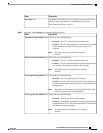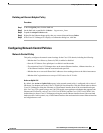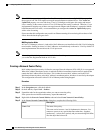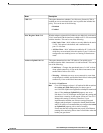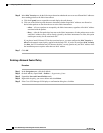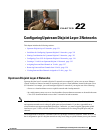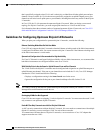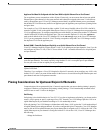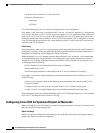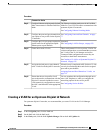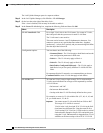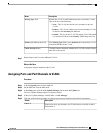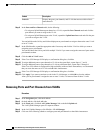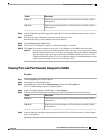
Appliance Port Must Be Configured with the Same VLAN as Uplink Ethernet Port or Port Channel
For an appliance port to communicate with a disjoint L2 network, you must ensure that at least one uplink
Ethernet port or port channel is in the same network and is therefore assigned to the same VLANs that are
used by the appliance port. If Cisco UCS Manager cannot identify an uplink Ethernet port or port channel
that includes all VLANs that carry traffic for an appliance port, the appliance port experiences a pinning failure
and goes down.
For example, a Cisco UCS domain includes a global VLAN named vlan500 with an ID of 500. vlan500 is
created as a global VLAN on the uplink Ethernet port. However, Cisco UCS Manager does not propagate this
VLAN to appliance ports. To configure an appliance port with vlan500, you must create another VLAN named
vlan500 with an ID of 500 for the appliance port. You can create this duplicate VLAN in the Appliances
node on the LAN tab of the Cisco UCS Manager GUI or the eth-storage scope in the Cisco UCS Manager
CLI. If you are prompted to check for VLAN Overlap, accept the overlap and Cisco UCS Manager creates
the duplicate VLAN for the appliance port.
Default VLAN 1 Cannot Be Configured Explicitly on an Uplink Ethernet Port or Port Channel
Cisco UCS Manager implicitly assigns default VLAN 1 to all uplink ports and port channels. Even if you do
not configure any other VLANs, Cisco UCS uses default VLAN 1 to handle data traffic for all uplink ports
and port channels.
After you configure VLANs in a Cisco UCS domain, default VLAN 1 remains implicitly on all uplink
ports and port channels. You cannot explicitly assign default VLAN 1 to an uplink port or port channel,
nor can you remove it from an uplink port or port channel.
Note
If you attempt to assign default VLAN 1 to a specific port or port channel, Cisco UCS Manager raises an
Update Failed fault.
Therefore, if you configure a Cisco UCS domain for disjoint L2 networks, do not configure any vNICs with
default VLAN 1 unless you want all data traffic for that server to be carried on all uplink Ethernet ports and
port channels and sent to all upstream networks.
Pinning Considerations for Upstream Disjoint L2 Networks
Communication with an upstream disjoint L2 network requires that you ensure that the pinning is properly
configured. Whether you implement soft pinning or hard pinning, a VLAN membership mismatch causes
traffic for one or more VLANs to be dropped.
Soft Pinning
Soft pinning is the default behavior in Cisco UCS. If you plan to implement soft pinning, you do not need to
create LAN pin groups to specify a pin target for a vNIC. Instead, Cisco UCS Manager pins the vNIC to an
uplink Ethernet port or port channel according to VLAN membership criteria.
With soft pinning, Cisco UCS Manager validates data traffic from a vNIC against the VLAN membership of
all uplink Ethernet ports and port channels. If you have configured disjoint L2 networks, Cisco UCS Manager
must be able to find an uplink Ethernet port or port channel that is assigned to all VLANS on the vNIC. If no
uplink Ethernet port or port channel is configured with all VLANs on the vNIC, Cisco UCS Manager does
the following:
• Brings the link down.
Cisco UCS Manager GUI Configuration Guide, Release 2.0
OL-25712-04 323
Pinning Considerations for Upstream Disjoint L2 Networks



